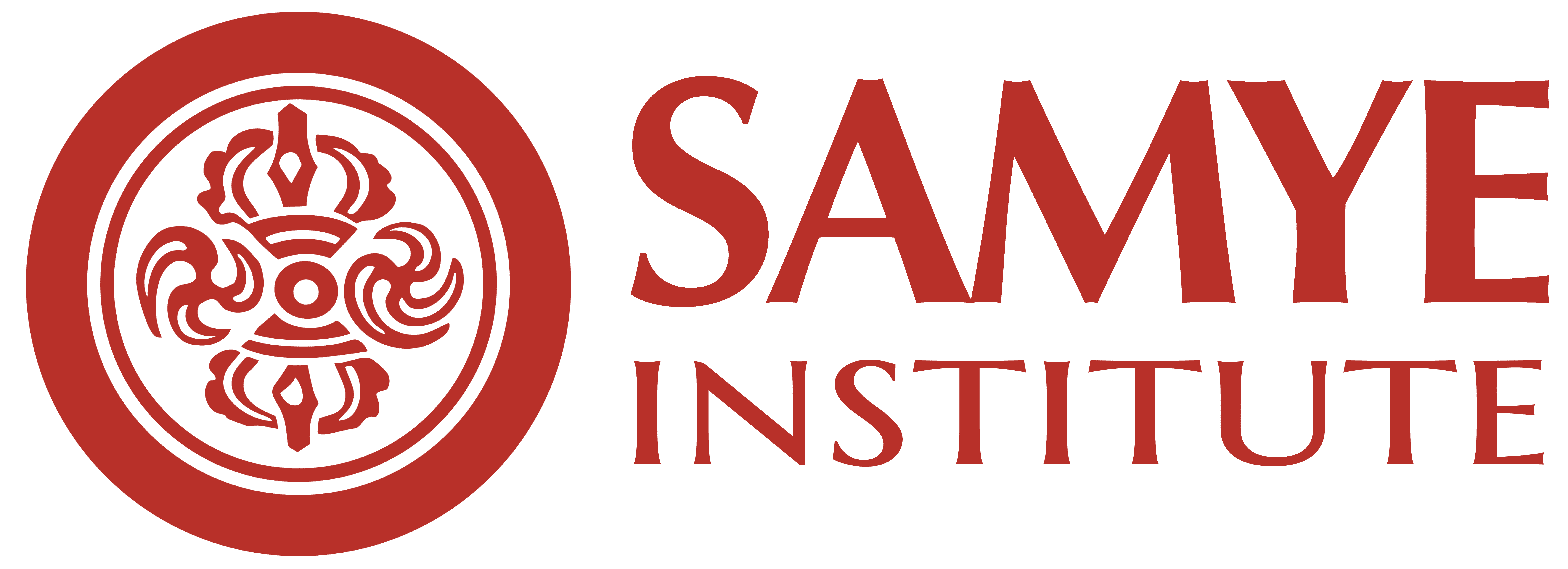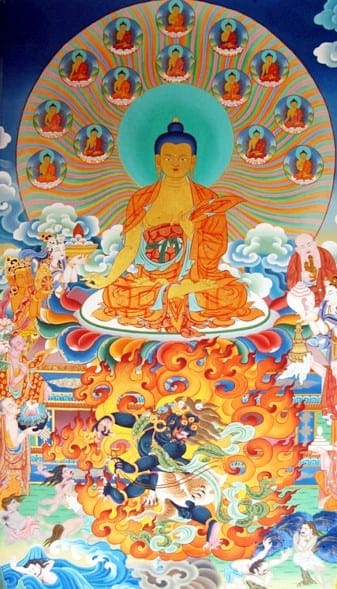Chötrül Düchen is one of the four major annual Tibetan Buddhist festivals. It takes place during the first fifteen days of the first month of the Tibetan new year when Śākyamuni Buddha’s fifteen-day performance of miracles to inspire faith and devotion in followers is celebrated.
History
About seven years after the Buddha’s awakening, leaders of six great non-Buddhist schools challenged the Buddha to a contest of miracles. Although the Buddha usually did not display all of his powers, he saw that this was a tremendous opportunity to change the beliefs of outsiders and inspire his own disciples. The Buddha agreed to participate in this contest at the city of Śrāvastī, the site of the Jetavana monastery. One version of the event describes the following miracles:
The First Set of Miracles
- On the first day, the Buddha pressed his tooth-stick in the ground, and it immediately turned into a beautiful tree full of flowers and ripe fruit.
- On the second day, he emanated two mountains of jewels.
- On the third day, he created a jeweled lake.
- On the fourth day, voices came from the lake explaining all aspects of the Dharma.
- On the fifth day, the Buddha radiated golden light from his face. This filled the entire world, purifying the afflictions of sentient beings.
- On the sixth day, he gave people the ability to read each others’ thoughts.
- On the seventh day, he transformed his Sakya clan benefactors into world-rulers.
- On the eighth day, the Buddha pressed down on his throne with the fingers of his right hand. At that moment, Vajrapani appeared from brandishing a flaming vajra at the six non-believing teachers. Members of Vajrapani’s retinue scattered the heretics and smashed the thrones of their teachers. The heretics fled in fear. At that point, the Buddha radiated eighty-four thousand rainbow-colored light rays. At the tip of each light ray sat a buddha on a lotus throne. And each of these was surrounded by attendants. Onlookers saw these buddhas teaching the Dharma, and many were liberated by just this sight.
The Second Set of Miracles
Because of this display, the ninety thousand followers renounced their former teachers, adopted the Buddhist Dharma, joined the monkhood, and later became arhats. Then, for seven more days Buddha Śākyamuni performed more miracles for the entire gathering and gave them teachings.
- On the ninth day the king of gods, Brahma, made offerings to Buddha. The Buddha expanded his body until it reached up to the highest heaven. Then, he emitted light rays into all directions while he taught the Dharma.
- On the tenth day, the four great kings who protect the Dharma invited Buddha to speak. This time, the Buddha expanded his body until it reached the height of samsara. And once again, he emanated light rays which then expounded the Dharma.
- On the eleventh day, the great patron Anāthapiṇḍada made offerings to the meditating Buddha. The Buddha concealed his physical body, but radiated a golden light, and projected his voice so that all could hear.
- On the twelfth day, Buddha entered into a meditation on great love, and golden light radiated from his body, extending throughout the worlds. These rays of light purified the three poisons from the onlookers and they gave rise to great compassion.
- On the thirteenth day the Buddha, while seated on the lion throne, emitted two rays of light from his navel. These light rays rose fifteen meters, and one each point was a lotus, and on each lotus, a buddha. From the navel of each buddha extended two rays of light and upon each point or these sat a buddha, teaching the Dharma while seated on a lotus throne. These buddhas filled all the world systems.
- On the fourteenth day, a king offered flowers to the Buddha. The Buddha transformed these flowers into chariots made of precious jewels. Then, the Buddha taught the Dharma to all beings as a doctor healed the sick.
- On the fifteenth, final day of the spring celebration, King Bimbisara made offerings to the Buddha. The Buddha asked King Bimbisara to bring vessels for food and these spontaneously filled with foods of a hundred different tastes. When the assembly ate, their bodies and minds were completely satisfied. Buddha then asked, “Why do we experience such immeasurable suffering in the world?” By his blessing, all beings, including demons, realized that they themselves had caused their own misery by their mistaken actions. When they realized this, the assembly all developed great faith.
Accumulating Merit During Chötrul Düchen
As Buddhist practitioners, we do not merely celebrate an ancient holiday. Of course, we recall the kindness of the Buddha and his great followers. Yet even more importantly, during this time devoted practitioners pay special attention to their conduct and their meditation. This month presents us with are a special opportunity to accumulate vast amounts of merit. That’s because during this period, all activities generate karma that is one hundred thousand times stronger. The Tibetan name refers to the number “bum” meaning multiplying by 100,000 all our actions. And that multiplication applies also on auspicious days! In this way, as we practice, we truly can accumulate vast amounts of merit for the benefit of all beings.
A Tremendous Opportunity
All the great masters teach that we need to accumulate both merit and wisdom in order to attain awakening and truly benefit beings. Thus, we can rejoice in this tremendous opportunity in this first month of the new year to skillfully act and practice for all sentient beings. We can rejoice in our precious human rebirth, and rededicate and inspire ourselves to engage in activities that alleviate suffering and bring true happiness.
And, we can use all the skillful means the Buddha, Guru Rinpoche, and all the great masters have taught. There are so many ways that we can make this month extraordinarily meaningful. We can supplicate, make offerings, go on pilgrimage, offer generosity to the sangha and to the poor, and make vast aspirations. Moreover, we can supercharge all of these by relying on Vajrayāna techniques such as multiplying mantras.


